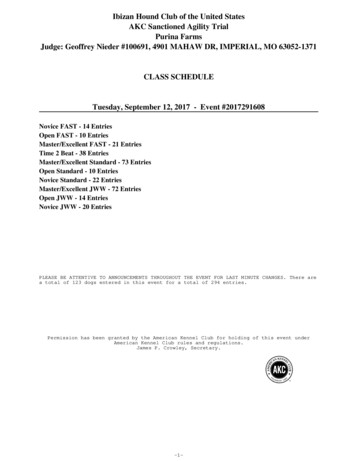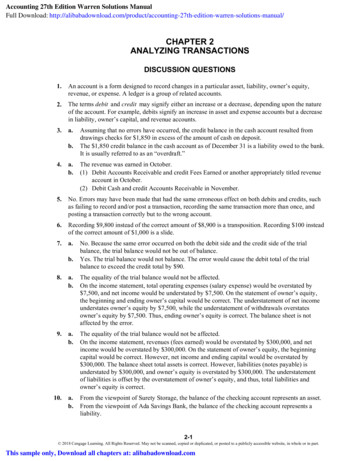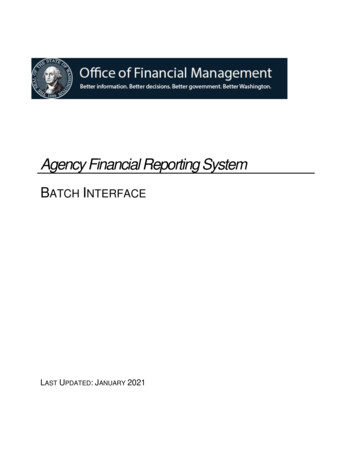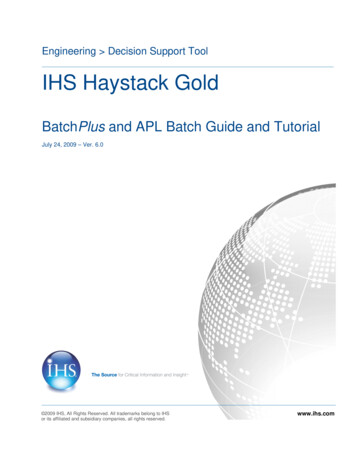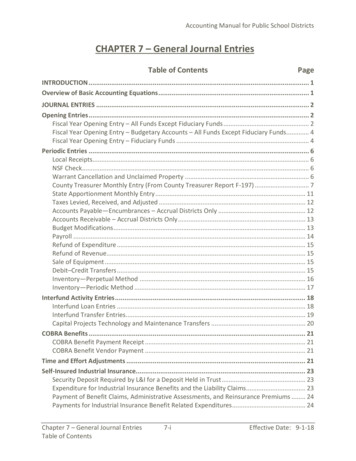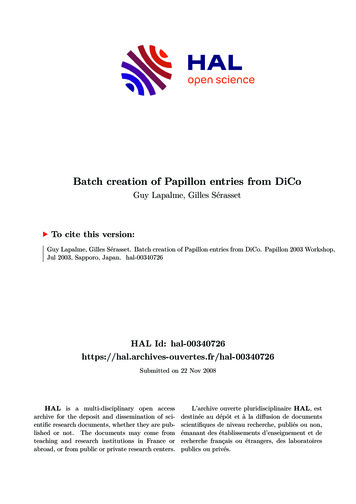
Transcription
Batch creation of Papillon entries from DiCoGuy Lapalme, Gilles SérassetTo cite this version:Guy Lapalme, Gilles Sérasset. Batch creation of Papillon entries from DiCo. Papillon 2003 Workshop,Jul 2003, Sapporo, Japan. hal-00340726 HAL Id: 0340726Submitted on 22 Nov 2008HAL is a multi-disciplinary open accessarchive for the deposit and dissemination of scientific research documents, whether they are published or not. The documents may come fromteaching and research institutions in France orabroad, or from public or private research centers.L’archive ouverte pluridisciplinaire HAL, estdestinée au dépôt et à la diffusion de documentsscientifiques de niveau recherche, publiés ou non,émanant des établissements d’enseignement et derecherche français ou étrangers, des laboratoirespublics ou privés.
Batch creation of Papillon entries from DiCoGuy LapalmeRALI-DIRO, Université de MontréalGilles SérassetGETA-IMAG, GrenobleJune 9, 2003AbstractThis article describes our experience in creating in one batch about 700 linked Papillon entries by transforming DiCo entries. Although this conceptually simple task seemsstraightforward, it has raised a number of interesting questions about the structureof the Papillon dictionary. We describe the steps of this conversion process as well asone false start, hoping that this experience will be useful for other researchers of thePapillon project.1IntroductionWhen the first author came to Grenoble for a few months during summer and autumn2002, his plan was to develop a text generator taking as input Papillon entries in order tohelp Papillon collaborators validate their input. As the complex relations and fields in aPapillon [7] entry can complicate the correct filling of entries, it was judged interesting to tryto provide users some linguistic feedback by generating example sentences from linguisticinformations already entered in the dictionary.In November 2002, as there was only one valid (in the XML sense) Papillon entry, wedecided to add more entries before building the example generator. In October 2002, FrançoisLareau [3] had just finished his Master’s Thesis in which, in the context of the SentenceGarden system, he provided DiCo court as basic data about 300 entries in the DiCo [6]formalism directly inspired by the DEC [5] of Igor Melčuk and his team. As the DEC hasalso strongly influenced the structure of Papillon entries, we felt that these DiCo entries couldbe used as a base for creating new Papillon entries.We will now give an overview of both DiCo and Papillon entries and then we will describehow we managed to transform one into the other.1
1.1Sample DiCo entryDiCo has been defined by Alain Polguère [6] based on a simple structure using a FileMaker Prodatabase. Figure 1 shows a sample entry as it is presented to a user who wants to consult,create or modify an entry. The only explicit structure is in the form of fields with possibleinternal line separators within some of them. The syntax of the fields is given by informalwriting conventions defined by the team at the Université de Montréal. It is possible to geta text only version of each entry by exporting the database as a tab separated line (internalline separators are coded internally with another control character).1.2Sample XML Papillon entryThe Papillon design principles have been described in the Ph.D. thesis of Mathieu MangeotLerebours [4]. Its format is defined as a hierarchy of XML Schemas whose fields, like DiCo’s,also follow quite closely Meaning-Text Theory and the DEC. A Papillon entry must then bevalidated according to these schemas. The three levels of Schemas are the following: dml.xsd defines a general structure for any computer based dictionary papillon.xsd defines language-independent information for any Papillon dictionary papillon fra.xsd defines language (in this case French) specific informationFigure 2 gives an example Papillon entry. It was produced by our system from the textualformat shown in figure 1.2First tryAs François Lareau had already developped, using Sicstus Prolog on Macintosh, a parserfor validating DiCo entries and transforming them in Prolog clauses, we thought it would besimple to use the Prolog clauses as input for creating Papillon entries. Unfortunately, the factthat Sicstus Prolog was not really well integrated on the Mac and that the Unicode codingof characters needed for XML entries was not convenient in Prolog programs raised sometechnical difficulties. But more important was the fact that Sentence Garden dealt only withlexical functions and government patterns, so we would have had to parse the original DiCofile anyway. Given our previous experience in using a Java program to create an XML file,we thought it would be simple and straightforward to process the whole DiCo file in Java.3Creating XML Papillon entries in JavaThe resulting Java program [2] (15 classes for about 1200 lines of code) proved to be morecomplex than expected because DiCo entries are not always systematic and also the fact thatdocumentation for the DiCo [3, 6] was not always up to date. As both Papillon and DiCo2
Figure 1: One DiCo entry via FileMaker Pro. This picture is taken from the master’s thesisof François Lareau [3].3
lexie d:id "REGRET.1" headword ln "1" regret /headword pos n.m. /pos semantic-formula formula-label sentiment /formula-label formula DE LA sem-actor sem-label personne /sem-label sem-variable X /sem-variable /sem-actor [. 5 lines] /formula /semantic-formula government-pattern mod nb "1" actor sem-variable X /sem-variable synt-variable I /synt-variable surface-group surface de N /surface surface A-poss /surface /surface-group /actor [. 9 lines] /mod /government-pattern lexical-functions function name "QSyn" valgroup value remords /value /valgroup valgroup value repentir /value /valgroup /function [. 13 lines] function name "Adv1" valgroup comment En éprouvant un R. /comment value à /value value condition " R. sans modificateur" avec fct-pattern [ ] /fct-pattern /value /valgroup /function [. 99 lines] /lexical-functions examples example d:id "REGRET.1.e0" On ne savait trop si cettepointe de regret concernait le décès du ministre ou lecaractère irréversible de ses décisions antérieures. /example /examples [. 3 lines] /lexie Figure 2: regret.xml generated from the tab-separated file corresponding to figure 14. The full entry having 166 lines, for saving space in this figure, some lines have been elided and are indicatedhere by square brackets.
entries are strongly linked, the conversion between them cannot be limited to a simple fieldto field transformation and/or reordering.Through the collaboration of Alain Polguère, Sylvain Kahane and Adil El Ghali, weobtained dicoTab.txt a new file of 772 entries using a similar DiCo format. From this file,we managed to create a 88 000 lines XML file with 613 lexies (337 different words) and 580links between them. These entries make 14 506 references to other 7 036 entries which wewould need to create in order to properly link them all. and this is not even taking intoaccount that new references would certainly appear in these entries. These lexies are nowintegrated in the Papillon database.The creation of a lexie closely follows the general structure of the XML entry shown infigure 2. As there are 8 subelements of a lexie element, there are eight Java classes foreach of them which take as input the necessary pieces of information from the DiCo fields.We limited the use of external Java classes to the ones already used in the Papillon project:Xerces XML parsers and Jakarta regular expressions.Here are some of the major quirks that we had to deal with when converting from DiCoto Papillon:1. the numbering of headwords are not always consistent between both formats, so somerearrangements and even heuristics had to be used to match them;2. in DiCo, some common informations to lexies are kept in an entry numbered 0 whilein Papillon this information has to be repeated in each one;3. part-of-speech tags do not follow the same conventions in DiCo and Papillon so somenon-trivial look-up procedures had to be devised in order to make them correspond;both projects should perhaps cooperate on this conceptually simple issue;4. Semantic Formula processing transforms a DiCo entry such as:sentiment: DE LA personne X À CAUSE DE SON action Y(X)into a Papillon entry as follows: semantic-formula formula-label sentiment /formula-label formula DE LA sem-actor sem-label personne /sem-label sem-variable X /sem-variable /sem-actor À CAUSE DE SON sem-actor sem-label action /sem-label sem-variable dep "X" Y /sem-variable /sem-actor /formula /semantic-formula 5
This is achieved by a mix of regular expressions matching on parts of the originalstring in order to retrieve the formula label and content with the explaining text andthe semantic actors (both label and variables).5. Government Pattern processing transforms a DiCo entry such as:X I de N, A-possY II à cause de N, à propos de N, de V-infinto the following Papillon one: government-pattern mod nb "1" actor sem-variable X /sem-variable synt-variable I /synt-variable surface-group surface de N /surface surface A-poss /surface /surface-group /actor actor sem-variable Y /sem-variable synt-variable II /synt-variable surface-group surface À cause de N /surface surface À propos de N /surface surface de V-inf /surface /surface-group /actor /mod /government-pattern Government patterns are amongst the least systematic fields of the DiCo and sometricks and heuristics had to be used to parse them. Informations in this field arerelatively tricky to enter without any strong guidelines or constraints in a text-onlyeditor. So in a way, it is quite surprising that DiCo entries are even parsable. Inparticular, end of lines which should appear only at the end of patterns often occurwithin them for formatting purposes; moreover, some patterns are explicitly taggedwith Reg. or Mod. while others are not. We thus had to remove all end of linesbefore separating the patterns using other hints and heuristics before applying regularexpressions to separate the different parts of a pattern.6
6. Lexical functions being a major component of both DiCo and Papillon, their processingis relatively involved. For example, from a DiCo entry such as{V0} regretter#1/*En éprouvant un R.*/{Adv1} à, avec [ ] R. sans modificateurone should produce a Papillon one like the following: lexical-functions function name "V0" valgroup value regretter#1 /value /valgroup /function function name "Adv1" valgroup comment En éprouvant un R. /comment value À /value value condition " R. sans modificateur" avec fct-pattern [ ] /fct-pattern /value /valgroup /function /lexical-functions Again in DiCo, there is a mix of new lines used as either separators between functionsor for formatting purposes; although by visual inspection of the entries, it is simple todistinguish both uses, it becomes quite tricky to sort these out by program. Anotherannoying problem is the fact that some characters, such as commas, which act as valueseparators can also be used in some contexts such as examples, comments or conditions.A mix of specialized tokenizers, regular expressions and local grammars are used toseparate the different uses.7. Finally, we add some information at the end of a Papillon entry to indicate that it wasgenerated automatically from a DiCo entry.4Linking lexiesThe main difference between on-line dictionaries such as Papillon and DiCo and paper ones isthe fact that their entries are strongly linked in order to ease their non sequential search andbrowsing. These links are a great asset and should be preserved when converting from oneformat to another. We limited ourselves to the processing of links between values of lexical7
functions with the corresponding lexie, when it is defined. This processing is performedafter creation of the lexies by creating a table of all headwords with the correspondingXML elements; values of lexical functions are then scanned in order to see if they refer to alexie present in the dictionary. If so, a link is created between the two lexies; for example, value regretter#1 /value in the previous example will be replaced by reflexie xlink:href "#REGRETTER.1" regretter#1 /reflexie If a corresponding value is not found, then this entry is kept in a table of undefined referenceswhich is printed at the end of this step. This is very useful for validating and checking theinternal coherence of the dictionary because it makes all undefined references stand out.This list could also be used for determining the most frequently referenced entries whichperhaps should be defined next. Matching headwords and lexical function values is currentlydone by matching the character strings, sometimes using also numbers and some informationabout their part-of-speech. A better coordination between DiCo and Papillon would help herealso to simplify this matching process. The links could also be corrected using the GUI ofPapillon.Some other minor modifications were also done on the Papillon Schemas such as addingallowed values in some enumerations or attributes to keep informations present in DiCo butnot in Papillon. This means that the basic schemas of Papillon are sound and appropriate forwide variety of uses. We detected some minor errors in the version of the DiCo we used asinput.5Related workGiven the fact that this transformation was a “one shot deal”, we might wonder if it wasreally worth the trouble. Currently, almost all Papillon entries have been converted fromother sources; the entries are partial ones (some have only their head) and so it is importantto understand the different types of conversion needed in almost all cases. The conversionprocess was helped by the formal definition of Papillon XML Schemas which were used asguides for programming. We think that almost all conversions will follow the overall processdefined in this paper: build an internal structure of an entry starting from the input formatand format the output according to the XML Schema; in our case, the use of the XML JavaAPI was a great help because we could concentrate on creating the lexies and linking themwithin a DOM object which is serialized at the end of the conversion process. This opensup new ways of building Papillon entries outside of typing XML text (with or without aspecial XML editor or stylesheet). For many users, it will be easier to use the DiCo or theirfavorite dictionary editors for entering their lexies which can then transfered automaticallyinto Papillon.Nguyen [1] has well described the issues around dictionary recovery in order to buildlexical resources; he defined a notion of structural and internal complexity of a dictionaryand its entries. He implemented a Common Lisp system for parsing electronic dictionary8
entries 1 into a special purpose internal form. Alternative dictionaries can be built from thisrepresentation using another formalism he has specified. In our case, the internal structurein a standard DOM structure which can be serialized into a XML file that can be validatedand used as input for the Papillon database. Other output forms could be obtained by usingstandard XSLT transformations. Nguyen has managed to process more than 30 resources(1,6 million entries), one of them being 100 entries from the MSWord file of Volume 2 of theDEC [5]. He encountered the same kinds of problems we described earlier: the authors ofthe DEC use a mixture of formatting conventions, unfortunately not always systematic, forindicating and separating fields and features. Nguyen makes only a passing reference to theimportant problem of linking lexies which proved to be an interesting challenge and the gistof the information in a structured dictionary such as Papillon.6ConclusionWe have described our experiment in transforming DiCo entries into Papillon in one batch.We had initially thought that this would be a straightforward task but it became quiteinvolved and it raised some interesting issues for both projects which share some importantaspects as they both rely on MTT and they both make heavy use of links between entries.This exercise was very instructive to us and productive for Papillon as it enabled thecreation of about 700 XML valid entries. It is thus a good base for creating other entries.Now it can be said that Papillon has been primed for French and we can pursue our initialgoal of creating an example generator of Papillon.References[1] Haı̈ Doan-Nguyen. Techniques génériques d’accumulation d’ensembles lexicaux structurésà partir de ressources dictionnairiques informatisées multilingues hétérogènes. PhD thesis, Institut National Polytechnique de Grenoble, Grenoble, Dec 1998.[2] Guy Lapalme. Création d’entrées Papillon à partir du DiCo. Technical report, GETAIMAG, Grenoble, Dec 2002.[3] Francois Lareau. La synthèse automatique de paraphrases comme outil de vérificationdes dictionnaires et grammaires de type sens-texte. Master’s thesis, Département delinguistique et de traduction, Université de Montréal, 2002.[4] Mathieu Mangeot-Lerebours. Environnements centralisés et distribués pour lexicographeset lexicologues en contexte multilingue. PhD thesis, Université Joseph-Fourier, Sept 2001.1which unfortunately often must be preprocessed with word processor macros in order to be more systematic9
[5] Igor Mel’čuk et al. Dictionnaire explicatif et combinatoire du francais contemporain:Recherches lexico-sémantiques I, II, III, IV. Presses de l’Université de Montréal,Montréal, 1984, 1988, 1992, 1999.[6] Alain Polguère. Towards a theoretically-motivated general public dictionary of semanticderivations and collocations for french. In Proceedings of Euralex’2000, pages 517–527,Stuttgart, 2000.[7] Gilles Sérasset and Mathieu Mangeot-Lerebours. Papillon lexical database project:Monolingual dictionaries and interlingual links. In Proc. NLPRS’2001 The 6th Natural Language Processing Pacific Rim Symposium, Hitotsubashi Memorial Hall, NationalCenter of Sciences, pages 119–125, Tokyo, Japon, 2001.10
help Papillon collaborators validate their input. As the complex relations and fields in a Papillon [7] entry can complicate the correct filling of entries, it was judged interesting to try to provide users some linguistic feedback by generating example sentences from linguistic informations already entered in the dictionary.
